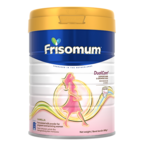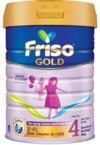Cara Mengatasi Kemurungan Selepas Bersalin
“Pospartum blues” adalah istilah yang sering digunakan untuk menggamba.... read more

Dear parents, this guide is here to help you learn about how to store formula milk, how long you can keep formula milk, and what to expect during the preparation process. Read more!
Formula milk like Friso® Gold 3 can play a huge part in your child's health - it is packed with essential nutrients such as Vitamin D, Vitamin B6, Vitamin E and C, Taurine, Selenium, GOS, Zinc and DHA which supports your child's overall growth and natural body resistance. Read on to learn more about these nutrients:
Vitamin D- Vitamin D is necessary for the absorption and utilisation of calcium and phosphorus. Tuna fish, sardines, cereals and milks fortified with vitamin D are great sources for this vitamin 1.
Vitamin B6- This vitamin is important for cell function. It helps with metabolism, creating blood cells, as well as keeps cells healthy. You can obtain this vitamin from foods such as tuna, cereals, poultry, leafy vegetables and some fruits like bananas and papayas 2.
Vitamin E- Vitamin E protects the fat in body tissues from oxidation. It is also an antioxidant. It is found in many foods including peanut butter, fruits like mangoes and avocados, collard greens and spinach 3.
Vitamin C- Vitamin C contributes to the absorption of iron from food. It is a powerful antioxidant that can neutralise harmful free radicals. The best sources for vitamin C are citrus fruits and vegetables such as oranges, grapefruits, broccoli, cabbages and more 4.
Taurine- Taurine is a naturally occurring sulphur-containing amino acid. Taurine becomes essential only in times of illness and stress. Seeing as it can be found in food such as meat, seafood, dairy and even your body produces it, taurine deficiency is incredibly rare 5.
Selenium- Selenium is a trace mineral and the body does not need a huge amount of it. It is a component of various enzymes and proteins that make DNA and protect against cell damage and infections. It can be obtained from chicken, beef, beans, lentils, cereals and more 6.
GOS- Galacto-oligosaccharides (GOS) are prebiotics that are found in dairy products, beans, and certain vegetables. GOS can help with constipation and more 7.
Zinc- Like Selenium, Zinc is a trace mineral and the body needs only a little of it. Zinc is essential for growth. Meats, poultry, and seafood are rich in Zinc 8.
DHA- Docosahexaenoic acid (DHA) is an omega-3 fatty acid. It is important in the development of eye and nerve tissues as well as reducing the risk of heart and circulatory disease. It can be found in tuna, salmon and more 9.
While it's always important to feed your child a milk formula that contains the right amount of nutrients, how you prepare, feed and store the formula is also important. Paediatric nutrition needn't be complicated: This guide is here to answer the questions you may have about how to store formula, how long you can keep it and to also provide helpful advice to get you through the process.
Before you start, wash your hands with soap. Ensure the drinking container/cup is properly cleaned or sterilised as they can cause a bacterial infection if not cleaned properly. If you're using a bottle and dishwasher, check that the bottle is dishwasher safe. Have the container, warm water, and formula ready at your countertop before you begin.
Preparation instructions are simple: Measure and add 5 levelled scoops of powder to 180ml of lukewarm water. If you prefer boiling your tap water, it should be cooled down to below 40°C before preparation. Swirl or lightly shake the bottle horizontally during mixing to reduce air bubbles before feeding.
You can keep the formula at room temperature for up to 1 hour after preparation, and store the milk formula powder in a cool dry place. The shelf life of Friso® Gold 3 formula powder is 2 years, but as a guideline the entire contents should be consumed within 4 weeks after opening. Be sure to check the packaging label; do not use expired formula supplies to save cost or peruse formula from a dented can as it might be contaminated with bacteria, which can cause illness.
Sometimes, your child might not want to consume the milk after you have mixed it. So how long can you keep the milk formula for if you have already prepared it and how to store it?
While some say that you can prepare some formula in advance, we advise that you use Friso® Gold 3 within 1 hour of preparation. It is specially formulated with LocNutri™ technology, where only mild heat treatment is used during the milk manufacturing process to preserve nutrients in its native structure. This prevents the proteins from getting damaged or destroyed, and helps prevent indigestion, colic, constipation and general stomach discomfort. By using the formula within the stipulated time, you reduce the chances of bacterial growth, and your child gets the easy-to-digest nutrition they need.
Also, do not keep any leftover formula after a feed. There's a chance that bacteria may have formed since then, so it's always best to play safe and discard for the sake of your child's health and immune system.
This is important as bacteria grows on everything. You need to keep a clean environment to protect your child both inside and out 10.
Here are several methods to clean your child’s feeding equipment.
- Boiling
- Steaming
- Handwash
- Dishwash
How long is the milk formula good for once mixed? Your child may actually prefer cold or room-temperature milk, and they will show you signs of their preference. So yes, you can store the mixed milk formula in the fridge, making sure to tighten the cap. Remember to use it within 1 hour of preparation as longer refrigeration can lead to bacteria accumulation. It might help to check the bottle nipple to ensure it is not clogged before feeding. Unlike some other formulas, you cannot keep a bottle of mixed Friso® Gold 3 in the fridge for 24 hours or more. Try to time the feeds according to your child's sleep schedule and chart their intake where possible.
If you need to heat up the milk that's been stored in the fridge, never use a microwave; it can cause dangerous "hot spots" in the liquid that can burn your child's mouth and throat. Always consider your child's safety first! Warming the refrigerated milk is easy - you can run the drinking container under hot water, use a bottle warmer, or place it in a saucepan of hot water (that's been taken off the stove). Shake vigorously, and test the temperature by squirting a few drops on your inner wrist. If it burns, let it cool for a few minutes at room temperature before checking again.
Now that you've learnt the various information and precautions, how long you can keep mixed formula milk as well as how long milk formula is good for once it is mixed, do share this with other parents and caregivers. Friso® Gold Malaysia wants what is best for you and your child.
Explore to know which formula is best suited for every age & how to switch formula to ensure your child’s preferred formula!
Find out more today on the steps on Friso® Gold Step 3 and Step 4 product page
Buy direct at Friso® Gold Malaysia


